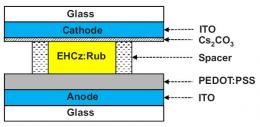Liquid-OLED Offers More Light-Emitting Possibilities
Liquid-OLED Offers More Light-Emitting Possibilities.
Recently, researchers have fabricated a “liquid-OLED” – an OLED that uses a liquid organic semiconducting layer to transport charge.
The scientists, Denghui Xu and Chihaya Adachi from the Center for Future Chemistry at Kyushu University in Fukuoka, Japan, have reported the liquid-OLED in a recent issue of Applied Physics Letters. As they explain, the novel design is based on a liquid-emitting layer, and could have advantages for flexible displays and other organic electronics applications.
Usually, OLED displays use solid-state organic films that give off light when an electric current is applied. One significant benefit of OLED displays compared to traditional liquid crystal displays (LCDs) is that OLEDs do not require a backlight. For this reason, OLEDs can be made very thin and flexible, as well as use less power, enabling them to run longer on a single battery charge.
The new liquid-OLED could achieve these same benefits, but by using a liquid organic semiconductor instead of the solid-state films. Other than a few previous studies that have investigated using polymer solutions as the semiconducting layer, this is the first time that researchers have attempted to fabricate a practical liquid semiconductor for OLEDs.


Recent Comments